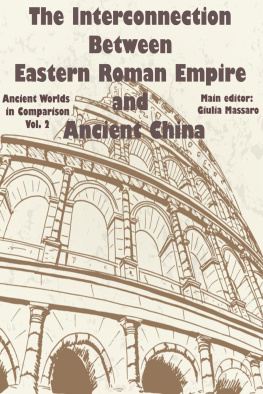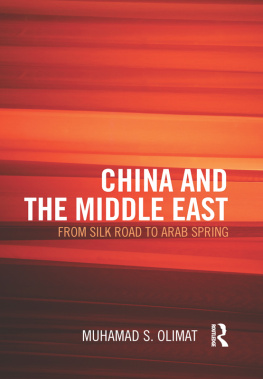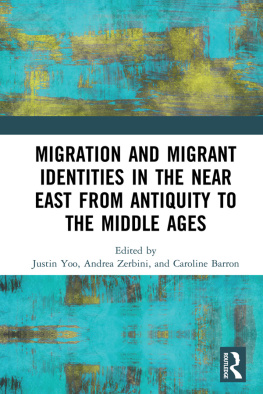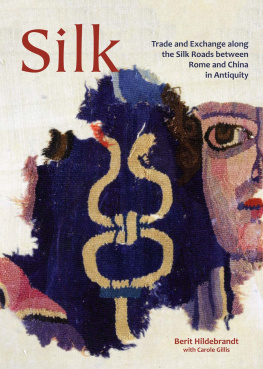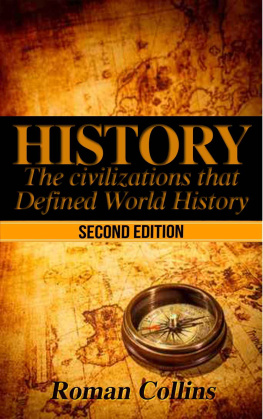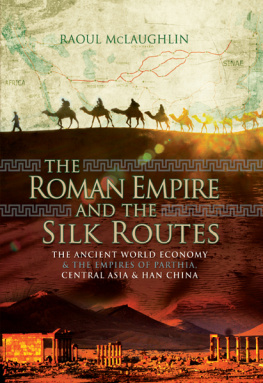Contents
The Interconnection Between Eastern Roman Empire and Ancient China
Volume 2 of the Book series: Ancient Worlds in Comparison
First published independently, August 2020
Book series editor: Giulia Massaro
Turin, Italy
This publication is in copyright, subject to the provisions of relevant collective licensing agreements. No reproduction of any part is permitted without the written permission of the editor.
In recent decades, studies on the relations of the Greco-Roman world with China have been paid more attention in international level. The studies are mainly relied on the written sources from the Mediterranean world about the Far East and those sources from China about the Far West the world that extended beyond Persia as well as the help of abundant archaeological materials, numismatics, epigraphy etc. Following the general academic tradition of the studies on the relations of the Greco-Roman world, this book volume will focus on the image of the Roman empire mainly the eastern part of the empire, known to Chinese as Da-qin, and including the regions of Syria, Palestine, and Egypt which was conceived by Chinese from the first century to the sixth century CE. Relying intensively on the Chinese sources referring to the Far West, as well as the parallel information provided by the Western sources, this study intends to recover this image, on which basis, to further expound on how ancient Chinese imagined, treated other states or people (or civilization), and its significance to the contemporary international relations. The basis of theory and methodology is the Imagology which originated from the French comparative literature explores literary images of foreign countries and peoples. This perspective on the subject has not been yet studied sufficiently, since most of the research has been very much rooted in topographical (identification of Da-qin and the routes of access to it), historical, and religious issues, as well as debates on mutual relations on the Silk Road through the criticism of the above sources.
The study of relations between the Roman empire and China (or Greco-Roman world and China) has been a fascinating subject to scholars from various disciplines for a long time, in particular to the sinologists. The study is both multi-disciplinary and multi-layered, as it focuses on the interactions between two of the greatest civilizations in ancient world in the fields of trade, diplomacy, literature, art and religion. As the subject covers vast geographical areas as well as a significant time span, it is necessary to consult a multitude of sources to verify each piece of information. Yet Western evidence is scarce: It is a little curious to speak about Greek-Chinese studies, since, except for some details about the commerce of Chinese silk and some geographical information given by Ptolemy, there is almost nothing else in the Western sources. [1] In reality, from the Classical period until the end of the early eastern Roman empire, a great Far East state named Seres, Thinae (or Sinae), Tzinitza (or Tzinista) [2] , and Taugast [3] was recorded in Greek and Latin sources with little and unclear information. Even so, after long-term research of various kinds of sources and linguistic comparisons, sinologists almost agreed that this state is ancient China [4] . Apart from the fuzzy image of the Far East state, there also exists little information on its relations with the Western world. The rarity of the sources from the West did not hinder the continuity of the study. The information concerning the Roman empire in ancient Chinese literature greatly supported and promoted the study of Roman-Chinese relations.
This information is either direct or indirect, and is impregnated with contrasting realities, misunderstandings, myth, and imagination. In the extant ancient Chinese literature, the term Da-qin [5] ( ) refers to a state situated in the extreme-west of ancient China. It made its appearance in Chinese literature from the second century BCE until the 19th century CE. [6] To be more specific, it features most prominently in the written or compiled sources dating from the first century to the seventh century, which record the history of this state from the first century until the sixth century. It is recorded as a great state located to the west of the state An-xi ( ), which has with certainty been identified with the Parthian empire [7] , and even west of the Xi-hai ( ), which means the Western Sea [8] ; it was the largest state to the west of ancient China; the state was abundant in treasures and all kinds of products, but the people wore barbarian clothing and used the barbarian (or foreign) language. In consideration of its detailed descriptions and its position in space and time, Da-qin has been almost unanimously identified as the Roman empire or part of it. [9]
As mentioned above, Da-qin had been attested in ancient Chinese literature since the first century [10] . It was first presented in a work called Bie-guo-dong-ming-ji (), which was a compilation of mysteries. It was written by a Chinese official with the name of Guo Xian who lived in the first century. In the text, there is a passage that states In the third year (108 BCE) of Yuanfeng period, state of Da-qin offered a bull with flower-shaped hoofs as a tribute (to the court of the Western Han) [11] . As far as we know, it is the first presence of Da-qin as a foreign state in the extant Chinese sources. Nevertheless, the information is brief enough, and nothing more is given than the name of the Da-qin state, so that it is accordingly difficult to trace its real identity. Besides, for the Roman Republic, considering the political environment on the Eurasian Steppe in the second century BCE, it is impossible to accept that there were direct relations between it and the Western Han of China [12] . The next event concerning Da-qin in the extant Chinese sources happened in the year 97. It is related to an envoy named Gan Ying. In the year 97, he was sent by the Protector General of the Western Regions Ban Chao to pursue relations with the states in the extreme west, and the main destination was Da-qin. On his return, he was obliged to submit his report of the mission, including the information on Da-qin. Although Gan Yings report was lost in history and we cannot check in detail what he reported, his mission, along with his description of Da-qin, was related by later historians, and his report is regarded as the beginning of information on Da-qin in Chinese sources. [13] Since then, much more often, Da-qin was depicted as a great state to the west of China in later Chinese sources. Though in ancient China, for different reasons, all kinds of disasters happened to written sources, leading to the loss of countless valuable works of literature, [14] as regards the extant sources, the descriptions on Da-qin were still handed down, and many of them are found in the sources from the period of the third century to the seventh century.

